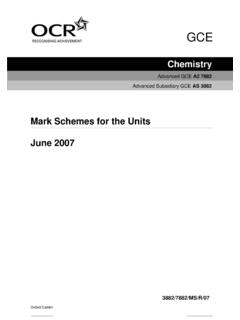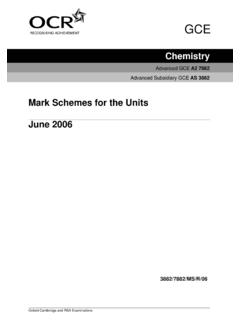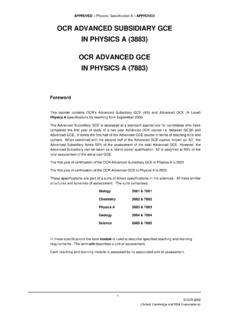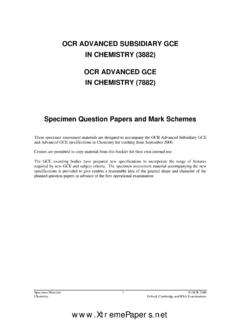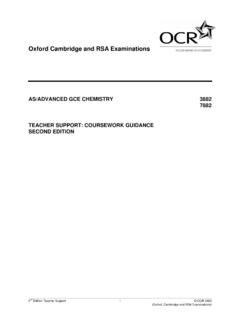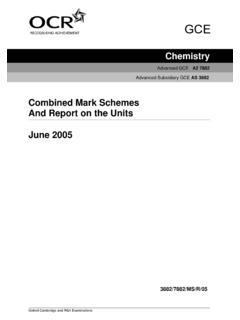Transcription of Report on the Units January 2008 - Frankly Chemistry
1 Oxford Cambridge and RSA Examinations GCEC hemistry advanced GCE A2 7882 advanced Subsidiary GCE AS 3882 Report on the Units January 2008 3882/ 7882 /MS/R/08J OCR (Oxford Cambridge and RSA Examinations) is a unitary awarding body, established by the University of Cambridge Local Examinations Syndicate and the RSA Examinations Board in January 1998. OCR provides a full range of GCSE, A level, GNVQ, Key Skills and other qualifications for schools and colleges in the United Kingdom, including those previously provided by MEG and OCEAC. It is also responsible for developing new syllabuses to meet national requirements and the needs of students and teachers. This Report on the Examination provides information on the performance of candidates which it is hoped will be useful to teachers in their preparation of candidates for future examinations.
2 It is intended to be constructive and informative and to promote better understanding of the syllabus content, of the operation of the scheme of assessment and of the application of assessment criteria. Reports should be read in conjunction with the published question papers and mark schemes for the Examination. OCR will not enter into any discussion or correspondence in connection with this Report . OCR 2008 Any enquiries about publications should be addressed to: OCR Publications PO Box 5050 Annesley NOTTINGHAM NG15 0DL Telephone: 0870 770 6622 Facsimile: 01223 552610 E-mail: CONTENTS advanced GCE Chemistry ( 7882 ) advanced Subsidiary GCE Chemistry (3882) Report ON THE Units unit /Content Page Chief Examiner s Report 1 2811 3 Foundation Chemistry2812 7 Chains and Rings2813/01 10 How Far?
3 How Fast?2813/2816/02 12 AS/A2 Coursework2813/03 14 How Far? How Fast? (Practical Examination)2814 16 Chains, Rings and Spectroscopy2815/01 20 Trends and Patterns2815/02 23 Biochemistry2815/04 26 Methods of Analysis and Detection2815/06 29 Transition Elements2816/01 31 Unifying Concepts in Chemistry2816/03 34 Unifying Concepts in Chemistry (Practical Examination)
4 Grade Thresholds 36 Report on the Units taken in June 2007 Chief Examiner s Report General Comments The two main entries this session continue to be Foundation Chemistry (16,402) and, Chains, Rings and Spectroscopy (nearly 9,199 entries). In addition, nearly 5,743 candidates took the AS Chains and Rings examination, the majority being re-sit candidates also sitting 2814. The majority of candidates taking 2811 were doing so for the first time. For How Far? How Fast?, over 1,187 candidates made use of the January session of the A2 year re-sit. Of these, 59% carried forward coursework, 18% took the coursework component and 23% the practical exam. Over 1,300 candidates were entered for Trends and Patterns. As in previous sessions, the most popular optional unit continues to be Transition Elements (51%), followed by Biochemistry (34%) and then Methods of Analysis and Detection (15%).
5 The entry of 2816/01 was small (only 300 candidates) and, except for one large centre, was again dominated by re-sit candidates. The majority of centres had an entry of just a single candidate. The entry for Foundation Chemistry continues to increase with 1,200 more candidates sitting the January 2008 exam than in January 2007. The entry for Chains, Rings and Spectroscopy also experienced the less dramatic increase on 440 candidates. Re-sit entries seem to have stabilised with similar entries in January 2008 as in January 2007. A feature of candidates responses is the great reliance placed by many on the published mark schemes. Some candidates seem able to memorise swathes of these documents and to reel these off almost verbatim when required. Ironically such candidates can sometimes be thrown completely by questions requiring application of Chemistry especially when tested within a novel context.
6 Entry to modules Centres are again reminded of the codes that are to be used for entry in those Units of assessment with more than one component. AS 2813 A How far? How fast? + Coursework 2813 B How far? How fast? + Carry forward coursework mark 2813 C How far? How fast? + Practical exam A2 2816 A Unifying Concepts + Coursework 2816 B Unifying Concepts + Carry forward coursework mark 2816 C Unifying Concepts + Practical exam Options 2815 A Trends and Patterns + Biochemistry 2815 B Trends and Patterns + Environmental Chemistry 2815 C Trends and Patterns + Methods of Analysis and Detection 2815 E Trends and Patterns + Transition Elements 1 Report on the Units taken in June 2007 INSET events for new GCE Chemistry A, for first teaching from September 2008 Get Started towards successful delivery of the new specification.
7 These new full day courses will give guidance and support to those planning to deliver the new AS/A level Chemistry A (H034/H434) specification from September 2008. Course dates and codes Tuesday 29 April 2008 (Newport, CCHE401), Wednesday 7 May 2008 (York, CCHE402), Wednesday 21 May 2008 (Plymouth, CCHE404), Wednesday 18 June 2008 (Manchester, CCHE406), Thursday 24 June 2008 (London, CCHE408). Fee 130 including refreshments, lunch and course materials. 160 if you book within 7 days of the course date. Places may be booked on these courses using the booking form available on-line ( ). Please quote the course code in any correspondence. 2 Report on the Units taken in January 2008 3 2811 Foundation Chemistry General Comments The overall impression of this paper was that it showed candidates performing at a slightly higher standard than in previous years.
8 In particular candidates seemed much better able to describe trends in ionisation energies, the test for the halide ions and the hydrogen bonding in water, than has been the case in earlier papers. Elsewhere there was also the feeling that candidates came very close to being awarded marks but failed to explain their answers in sufficient detail and perhaps, as a result of rushing, did not do themselves full credit. This was certainly true of the answers to 1(d) and 2(a)(ii) and again in 3(b)(ii). Candidates should be encouraged to read the question very carefully and to take a little time thinking about how best to explain the answer. Of all the areas examined here the greatest weakness still remains candidates' understanding of how intermolecular forces are involved in changes of state.
9 All too many candidates seem content to venture answers which suggest that covalent bonds are broken when compounds are vaporised. This reveals a true lack of understanding and is an area on which candidates should concentrate for the future. Comments on Individual Questions Question 1 (a) (i) Almost all candidates got off to a good start with this opening question. As in other parts of the paper, candidates should be careful not to rush but rather to make sure that they take the time to convey fully the answer. For example some candidates lost the mark here by writing 'elements with different number of neutrons', rather than atoms of the same elements with .. (ii) Very few candidates failed to pick up these easy marks. (b) (i) As in previous years this stock definition still failed to furnish many candidates with all three possible marks.
10 Most common of the possible errors was to fail to convey the idea of an average or weighted mean mass. In addition, there were a number of candidates who used 'moles of atoms' or 'grams' in an incorrect manner. (ii) This was well answered with the majority of candidates identifying that the boron-11 isotope must occur in greater abundance. Pleasingly a handful also worked out that this figure is 80%, although this did go beyond the required answer. (c) (i) Candidates really struggled with this equation despite the fact that both reactants and one of the two products are given in the question. Many, as is often the case, were let down by a lack of simple chemical knowledge and so led to venture incorrect formulae for potassium hydroxide and thus making the equation impossible to balance correctly.
